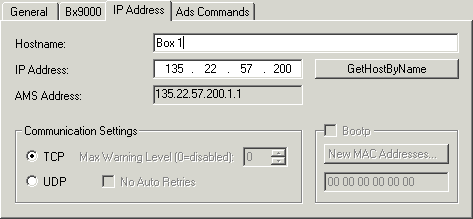The IP Address tab
Ethernet components require an unambiguous IP address in the network. The setting dialog necessary for configuration of the fieldbus nodes in the TwinCAT system is described below. The tab illustrated appears after you have selected a BK9000, BC9000 or other Ethernet fieldbus device with the right mouse button (Add box) under your Ethernet cards in the System Manager.

Host name
The name of the Bus Coupler station can be edited here.
IP address
Enter the IP address of the Bus Coupler here.
GetHostByName
By clicking this button you can (as from BK9000 firmware version B2) obtain an IP address from a Windows 2000 DHCP (Dynamic Host Configuration Protocol) server.
AMS Address
Reports the Bus Coupler's AMS Net ID. It is automatically generated from the IP address by adding two additional bytes (e.g. ".1.1").
BootP
This checkbox can be activated if the Beckhoff BootP server has been installed and started (as from TwinCAT Version 2.8).
New MAC Addresses
If the Beckhoff BootP server has been started, the MAC addresses (Media Access Controller) of Ethernet fieldbus devices that have newly been connected can be displayed by clicking this button. If only one new Ethernet fieldbus device has been connected, then only one new MAC address will accordingly be displayed. You can then assign it to the desired IP address in the IP address field described above. Each time another Ethernet fieldbus component is added you can repeat this process on the tab described here for the new device.
Communication Settings
Settings for IP (Internet Protocol) communication.
TCP
If this option is active (which is the default) the communication is handled by TCP (Transmission Control Protocol). This means that telegram packets to and from Bus Couplers are exchanged using a reliable (acknowledged) mechanism.
UDP
If this option is selected, communication is handled by UDP (User Datagram Protocol). In contrast to TCP, the individual telegram packets are not exchanged using a reliable mechanism. They are, in other words, not individually acknowledged by the receiver after they have arrived. Telegram packets that are damaged or whose sequence has become disturbed are neither re-sent nor sorted. The advantage of UDP is that the telegram transfer times can be calculated, because it is not necessary to wait for an answer from the receiver. It is therefore possible to talk of UDP in terms of a limited real-time capability.
Max. Warning Level
This setting option is only active with UDP. The maximum value of the error counter can be entered here. Waiting for response telegrams from the fieldbus node stops when the set maximum value has been reached. Instead, read telegrams only, based on a higher cycle time, are sent to the fieldbus nodes.
No Auto Retries
This checkbox also can only be selected when the UDP option is active. If this checkbox is active, then when the level set under Max. Warning Level has been reached it will be necessary to execute the IO/Reset function. No outputs will be output as long as no reset has been triggered.